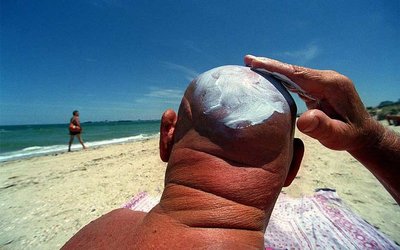
Sunburn is serious business.
Share
What is sunburn? Sunburn is a radiation burn that affects living tissue (skin, for example) that is caused by an overexposure to ultraviolet (UV) radiation-usually from the sun. It is painful, yet many just assume it is a part of summer. It doesn't have to be.
Sunburn is a radiation burn that affects living tissue (skin, for example) that is caused by an overexposure to ultraviolet (UV) radiation-usually from the sun. It is painful, yet many just assume it is a part of summer. It doesn't have to be.
Symptoms can include blistering, swelling, edema, itching, peeling skin, rash, nausea, fever, chills, and fainting. Also, a small amount of heat is given off from the burn, caused by the concentration of blood in the healing process, giving a warm feeling to the affected area. Blistering is a sign of second degree sunburn.
With the ozone layer providing less and less protection from UV rays, sunburn is becoming more common. Sun protective measures including sunscreen (like our Beau Soleil) and sun protective clothing are widely accepted to prevent sunburn. Special populations including children are especially susceptible to sunburn and protective measures should always be used (thinking about our Gingers out there!).
Did you know?
Sunburn can occur in less than 15 minutes (even in overcast weather), and can even happen in seconds (when exposed to non-shielded welding arcs or other sources of intense ultraviolet light). Nevertheless, the inflicted harm is often not immediately obvious...
Common symptoms in humans and other animals include red or reddish skin that is hot to the touch, pain, general fatigue, and mild dizziness. An excess of UV radiation can be life-threatening in extreme cases. Excessive UV radiation is the leading cause of primarily non-malignant skin tumors.
Sunburn is an inflammatory response in the skin triggered by direct DNA damage by UV radiation. When the skin cells' DNA is overly damaged by UV radiation, type I cell-death is triggered and the skin is replaced.
After the exposure, skin may turn red in as little as 30 minutes but most often takes 2 to 6 hours. Pain is usually strongest 6 to 48 hours after exposure. The burn continues to develop for 1 to 3 days, occasionally followed by peeling skin in 3 to 8 days. Some peeling and itching may continue for several weeks.
Minor sunburns typically cause nothing more than slight redness and tenderness to the affected areas. In more serious cases, blistering can occur. Extreme sunburns can be painful to the point of debilitation and may require hospital care.
 After the exposure, skin may turn red in as little as 30 minutes but most often takes 2 to 6 hours. Pain is usually strongest 6 to 48 hours after exposure. The burn continues to develop for 1 to 3 days, occasionally followed by peeling skin in 3 to 8 days. Some peeling and itching may continue for several weeks.
After the exposure, skin may turn red in as little as 30 minutes but most often takes 2 to 6 hours. Pain is usually strongest 6 to 48 hours after exposure. The burn continues to develop for 1 to 3 days, occasionally followed by peeling skin in 3 to 8 days. Some peeling and itching may continue for several weeks.
What's the big deal about sunburn?
Ultraviolet radiation causes sunburns and increases the risk of three types of skin cancer: melanoma, basal-cell carcinoma, and squamous-cell carcinoma. Of greatest concern is that the melanoma risk increases in a dose-dependent manner with the number of a person's lifetime cumulative episodes of sunburn. It has been estimated that over 1/3 of melanomas in the United States and Australia could be prevented with regular sunscreen use.
Treating sunburn and ameliorating damage done is important, which is why Haven makes Disco Inferno (for burns, baby! burns!).
The best things to do for a sunburn, according to the Skin Cancer Foundation, is:
1. Act Fast to Cool It Down
We recommend keeping Disco Inferno in the fridge- not only does it have healing herbs in an easy to apply lotion, but it also contains menthol for immediate cooling- and this effect is increased if kept cold.
2. Moisturize While Skin Is Damp
Apply Disco Inferno after a cooling shower, while you are still a tad damp for best effect. It is a lotion, so it moisturizes and treats the problem.
3. Decrease the Inflammation
Disco Inferno contains herbs that do this.
4. Replenish Your Fluids
While you recover, increase your fluid intake! Healing takes moisture!




